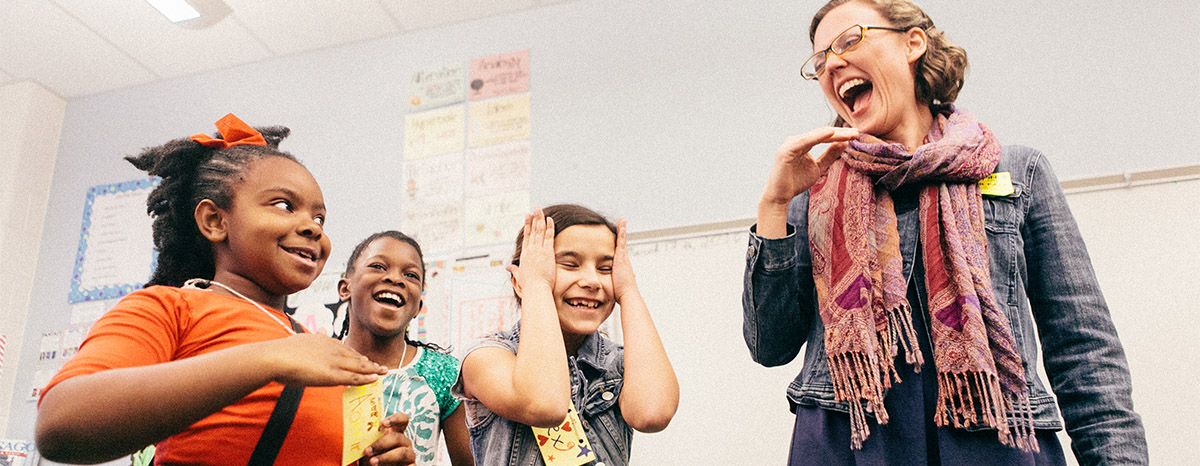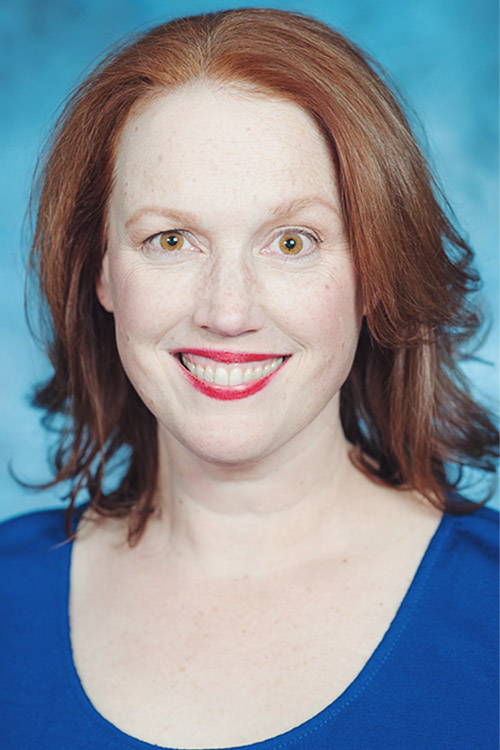July 29, 2020
Meet our teaching artists!
Teaching artists are professional performance and creative educators who work closely with Lyric’s Learning & Creative Engagement Department to develop and build curriculum for programs in schools and communities. For programs like Lyric’s Opera Residencies, our teaching artists partner with classroom teachers to create custom learning experiences that support music, arts, and academic learning goals. During this shift into the digital realm, we have been collaborating closely with the Opera Residency teaching artists to create videos with Illinois State Board of Education guidelines in mind. These videos can be found at Kids Corner, a new online portal filled with activities and learning resources the whole family can enjoy. We greatly appreciate the work of our teaching artists. Get to know Heather Aranyi, Megan Elk, Elise LaBarge, and A.J. Wester, and their many talents below!
How many years have you been involved as a teaching artist with Lyric's learning programs?
I've been working at Lyric since 2010.
What is the role of a teaching artist?
A teaching artist is a master innovator in the arts. We combine multiple disciplines to cocreate, with our participants, outstanding works of art which reflect their lived experiences.
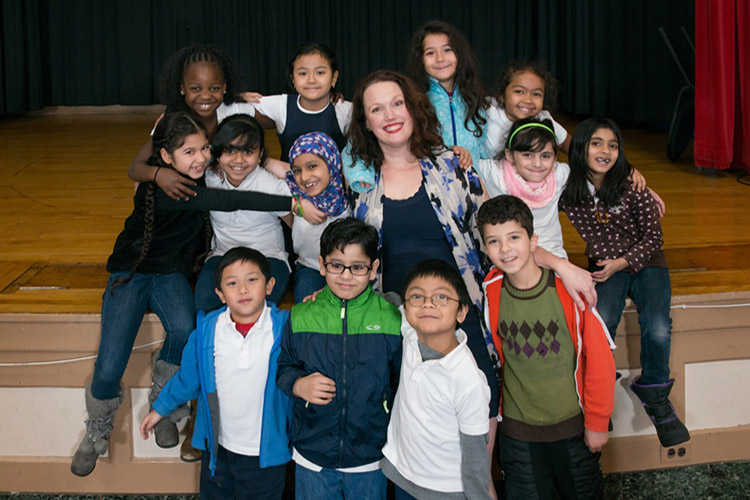
Heather teaches at Volta Elementary School.
What is a favorite moment or story you have from your work with students?
I have so many! My favorite moment occurred Spring of 2019 at Wrigley Field. As part of Lyric's High School Choir Residency, I have worked with the brilliant educator and composer Trevor Nicholas since 2016 at Senn High School. The choir has transformed into one of the top choirs in the country and the choir was selected to lead the national anthem at a Cub’s game. Standing with Trevor on the field, I saw the students transform. It was a life changing and magnificent moment for them. It is a great honor and responsibility to represent Lyric and cocreate amazing works of art with participants. I have worked with thousands of students and every story is unique, every show is unique. I carry their stories with me.
Why do you think art is an important part of a child's education?
In addition to being at Lyric, I am also on faculty at the Farley Center for Entrepreneurship and Innovation at Northwestern University. One of my areas of research is the innovative use of music, and specifically singing, to heal the body. Most recently, I gathered with an interdisciplinary group of fellow scholars at the Buffett Institute for Global Affairs to discuss potential research projects in the areas of trauma, music, and the breath. Brain imaging is providing the data to support what teaching artists have seen for centuries: our work is profound and life changing.
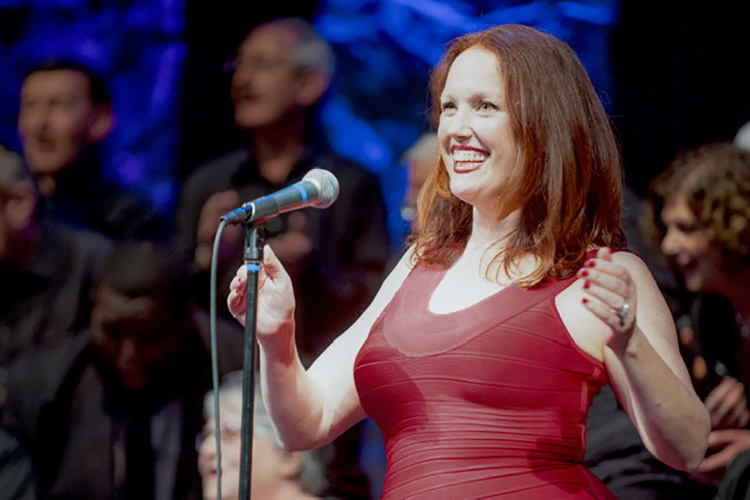
Heather is also an ordained Cantor at Congregation Beth Am. Here she is singing at their annual gala.
Megan Elk
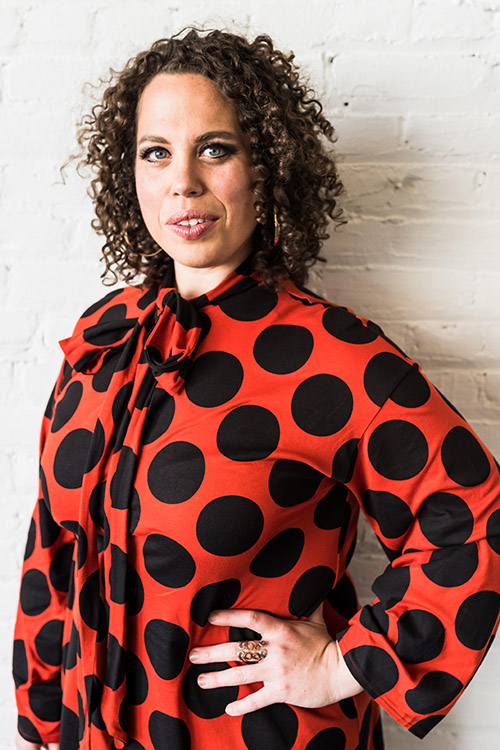
Megan Elk, teaching artist
How many years have you been involved as a teaching artist with Lyric's learning programs?
I've been working in various capacities for Lyric Unlimited since the Chicago Voices project in 2016. I've done everything at Lyric from composing original music with community organizations, to helping second-graders write operas about bugs, to coproducing an entire album of music written by teen songwriters in an incredible one-week intensive (listen here!).
What is the role of a teaching artist?
To me, the job of a teaching artist is simple: to energize students around the arts and teach them the collaborative and creative tools to create art together as a group. We're not studying art, or music, or opera per se. We're learning about the performing arts by actually doing them, actually writing and devising our own work.
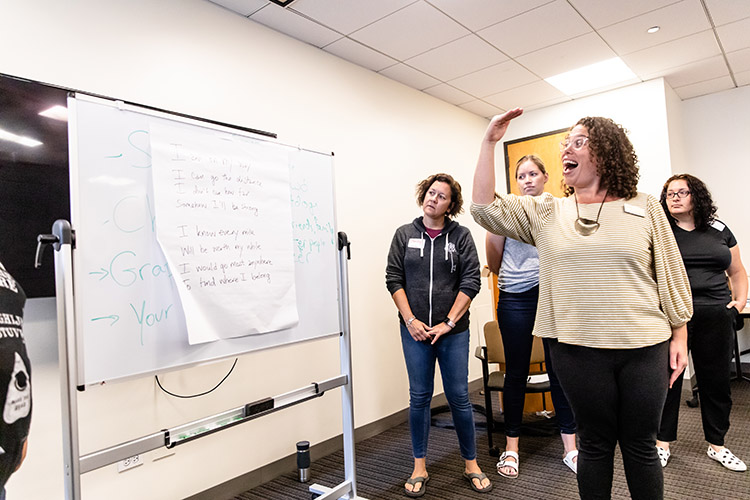
Megan Elk leads an excerise during the 2019/20 Season's Teacher Professional Development Workshop.
What is a favorite moment or story you have from your work with students?
In my career as a teaching artist I've had so many incredible moments, but something very special happened just recently. One of the schools where I was in my second year of residency just sent me their year-end video and, much to my surprise, the soundtrack of the video was one of the songs I had taught them. They loved that song so much that it became their anthem for the whole year. It really moved me to think about having had such a profound and lasting impact.
Why do you think art is an important part of a child's education?
I think art is important for a child's education because art allows the brain to work differently, to be expansive, to say yes to ideas that might not seem possible. Art gives antsy kids the green light to use up all their energy dancing around the room in the very same moment that it gives introspective kids an opportunity to craft lyrics and playscript and bossy kids a chance to direct. Everybody plays. Everybody grows. Everybody wins. As a young person whose neural pathways were anything but typical, I am sure I gravitated toward a life in the arts for some of these very same reasons!
"One sentence opera" with Megan!
Learn how to create an opera using one sentence with Megan. You only need three cups and some paper to participate!
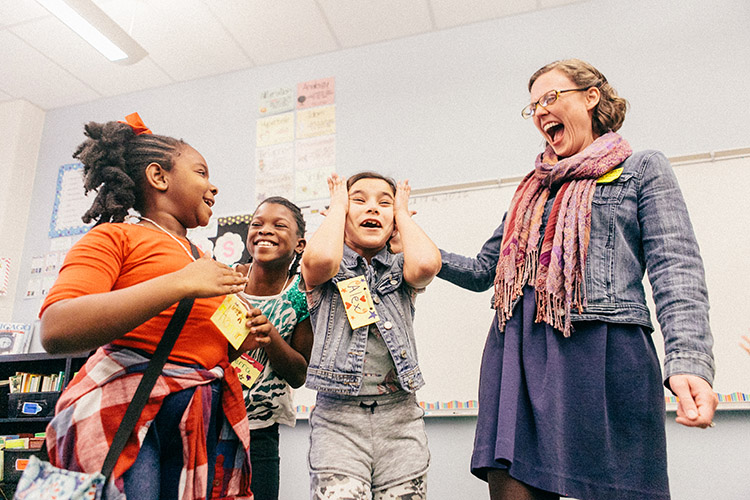
Elise LaBarge teaches at Skinner West Elementary in Chicago, Illinois.
How many years have you been involved as a teaching artist with Lyric's learning programs?
I moved to Chicago in the fall of 2012 and started working with Lyric right away. Before that, I was a teaching artist and education coordinator for six years with Union Avenue Opera in St. Louis.
What is the role of a teaching artist?
As a Lyric teaching artist, I am invited into classrooms and community spaces to engage with groups of people who are looking to make and/or greater appreciate opera. My role as a teaching artist shifts depending on where I am and who I am with. That’s the beauty of the practice! It is intentionally flexible because each group has different needs and is starting from a different place. With our Elementary Opera Residencies, I take students through the art-making process in collaboration with classroom teachers, carefully aligning our project with each teacher’s specific curricular and social-emotional goals. I teach acting and singing skills along the way, and end the residency with the students’ performance of their original music-theater piece. On Family Day, I teach members of the general public to conduct and to hear stories in the orchestra’s music. In high school choir rooms, I help directors with anything and everything that comes up, including ensemble-building, musicianship and vocal technique. This job is never boring.
What is a favorite moment or story you have from your work with students?
When I need kids to quiet down, I’ll often sing a single pitch. The kids learn on Day One to start singing that pitch with me until I give them the signal to stop singing and to listen. It works like a charm! I had been working with the third graders at a Logan Square school for four years when I participated in an all-school assembly. It was time for my group to stand up and perform, but the audience was too noisy! Instead of raising my voice, I sang my single pitch. One by one, all of the classes I had worked with in the past started singing with me…with each other. Soon, the majority of the large CPS auditorium was singing the same note at the same time: an audible representation of community. It was magical. It also showed the value of sharing our musical passions—I hadn’t seen many of those kids for years, but they remembered me and the work that we did together.
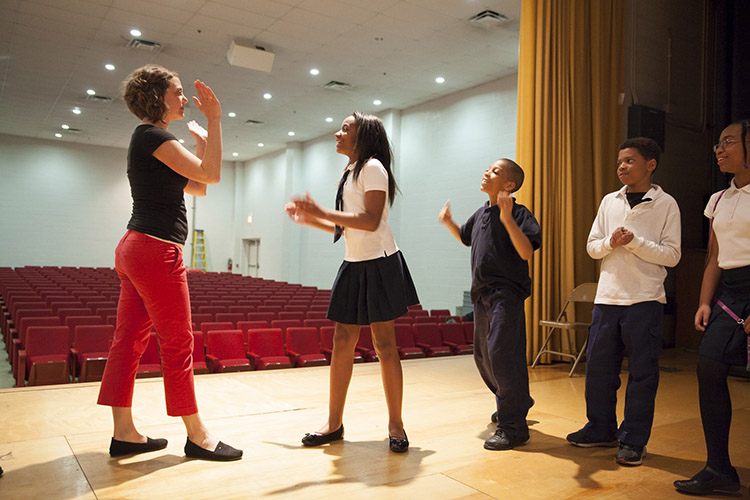
Elise teaches "pass the clap" during her residency at Coleman School in Chicago, Illinois.
What first got you interested in the arts?
I’ve been singing since I could talk, according to my parents, and always had a flair for drama. It helped that my father was enamored with opera, and my four older brothers sang in a barbershop quartet as kids. I was insanely jealous of them until I found my own outlet with the St. Louis Children’s Choirs. I sang with the group for six years and met my lifelong friends during rehearsals, concerts, and choir tours. We still sing together 25 years later, even though we live in different corners of the country. Thank goodness for technology and singing apps!
Why do you think art is an important part of a child's education?
Kids spend a lot of time learning about things with right and wrong answers, and then they leave school and find out that most of the world isn’t so clearcut. Giving young people the opportunity to answer with imagination rather than “yes” or “no" not only elevates their capacity for problem-solving, but also provides a moment of levity in what has become the very serious business of learning. When students create theatrical and musical art together, the focus is taken from typical measurements of academic success and placed more on community building, support, self exploration and expression, risk-taking, friendship, and joy. Classroom engagement and literacy are very happy side effects, even (especially!) for the least accomplished readers and writers in the room. The question is, how could this NOT be important for every child to experience?
"Opera laughs" with Miss Elise!
Learn how laughing can help with your singing with Miss Elise! Join the fun by tagging us in your own opera laughs video with #lyricoperalaughs.
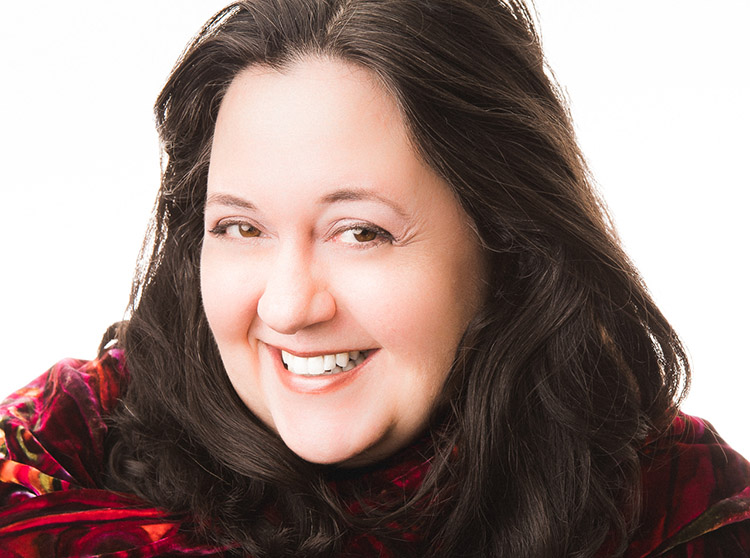
A.J. Wester, teaching artist
How many years have you been involved as a teaching artist with Lyric's learning programs?
I have been a teaching artist with Lyric since 2011. I have worked for the Elementary and the High School programs. However, I have spent most of my time as part of and developing the High School programs (Explore Opera—formerly Teen Opera Circle and the High School Choir Residency.)
What does being a teaching artist mean to you?
I have been a teaching artist now for almost 20 years. It can mean so many different things to different teachers and organizations. I feel it is the most exciting when it is a true collaboration between the classroom teacher and the teaching artist. I come with my skill set as a singer, voice teacher, acting teacher, and stage director. I can use that to really open up the possibilities for education. Every student learns differently and having a second “vocabulary” in the room can sometimes help students grasp a concept that they couldn’t quite grasp before. With high school students, I am a resource. I’ve worked for so many arts organizations and still have connections to all of them. I can open up a pathway for them that they weren’t aware of. When that happens, it is so exciting for me.
Art helps us see the world through the eyes of the “other” in a way that nothing else can. That will make any child a better citizen of the world and a better human.
What is a favorite moment or story you have from your work with students? What first got you interested in the arts?
I don’t remember a time when I wasn’t involved in the arts. My mother played piano. She bought a piano when she was pregnant with me and told me that she played all the time during her pregnancy. So, I feel like I came out of the womb with music. Also, my high school had an amazing theater department (Yay Johnsburg High School in Johnsburg, IL). My older sisters were involved and I lived and breathed theater during high school. My favorite moment of being a teaching artist has always been when students find a way to connect the arts to what they feel is important right now. At Lyric, I had a poignant residency with Lakeview High School for The Passenger. The projects were so amazing that the students had created about the Holocaust that the school did an assembly to highlight the work that they had done. There was not one student in that residency that was not touched by that work. It really brought the horrors of the Holocaust home to them in a way that just simply reading a book or watching a documentary couldn’t have done. I also remember,at Northside College Prep,a student did a presentation of Aïda through recordings. It was amazing. I think this kid would have given Lyric Dramaturg, Roger Pines, a run for his money!
Why do you think art is an important part of a child's education?
There are so many ways it helps a child. One of the most important things that art teaches is creativity. It is a very hard skill to teach in school. There is such an emphasis on “getting things right” and test-taking in the modern school setting, that it is often forgotten that creativity is one of this country’s greatest assets. It is often listed as a top skill that many employers are looking for in multiple industries. Also, we live in a world now where empathy is in short supply. Art teaches empathy. I’ve often stated it is an empathy playground. It helps students see the world through different cultures, mindsets, and ideas. There is so much tribalism in our politics, culture, and day-to-day lives. Art helps us see the world through the eyes of the “other” in a way that nothing else can. That will make any child a better citizen of the world and a better human.
